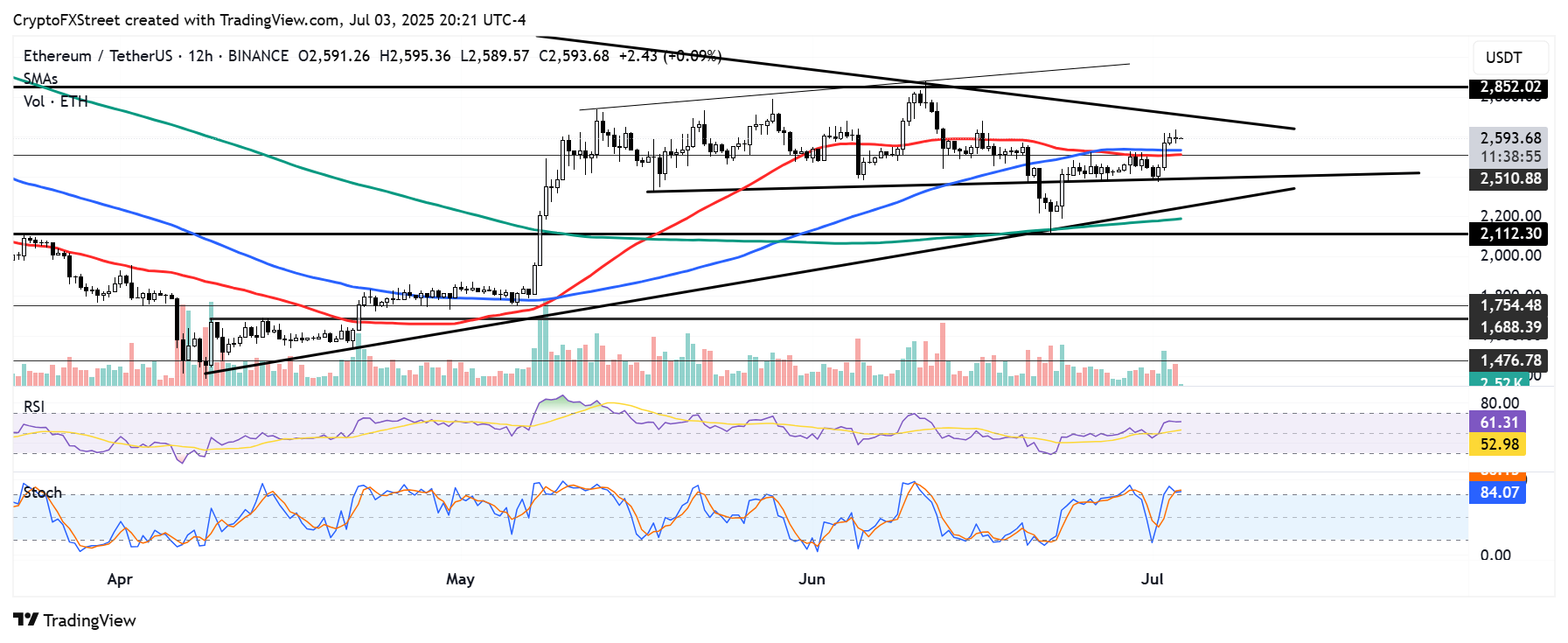Ethereum Price Forecast: ETH ETFs can enjoy staking yields without losing liquidity follow
July 3, 2025
- Ethereum ETFs can participate in staking without compromising liquidity requirements following the Pectra upgrade.
- Pectra upgrade introduced EIP-7251 and EIP-7002, which increased the maximum staking balance and introduced partial withdrawals.
- ETH eyes a return to the $2,300-$2,500 range after bulls lost momentum near $2,650.
Ethereum (ETH) trades above $2,500 on Thursday, as digital asset price provider CF Benchmarks revealed in a report that the Pectra upgrade has empowered ETH exchange-traded funds (ETFs) with the ability to efficiently earn staking yields without compromising high liquidity standards.
Ethereum ETFs no longer have to sacrifice yield to maintain liquidity standards following the Pectra upgrade, according to areport by CF Benchmarks.
“Pectra transforms Ether ETFs from passive exposure vehicles into comprehensive total return products that deliver both capital appreciation and staking income without compromising investor access to funds,” wrote James Flamant, Senior Product Manager at CF Benchmarks.
Developers executed Pectra on May 7, transforming the Ethereum network through the implementation of nine Ethereum Improvement Proposals (EIPs).
The report highlighted how fund managers can efficiently participate in staking in the post-Pectra era by consolidating their stake and compounding yield through the implementation of EIP-7251.
EIP-7251 increased the maximum staking balance from 32 ETH to 2048 ETH while maintaining the former as the minimum threshold. Prior to the Pectra upgrade, fund managers interested in staking had to run several validators in small batches of 32 ETH without the ability to compound returns.
“Previously, once a validator hit 32 ETH+ earnings, anything above 32 didn’t count toward earning more rewards unless re-staked,” the report states. However, “EIP-7251 reduces fragmentation and allows auto-compounding of staking returns, which boosts yield potential for an ETF that keeps rewards invested.”
Flamant also noted how EIP-7002, which enables partial staking withdrawals without complete validator exits, allows fund managers to allocate up to 75-95% of assets to staking without compromising their ability to meet redemption requests.
“This transformation effectively converts staked ETH holdings above the minimum requirement into readily accessible liquidity reserves for fund operations,” he wrote. “Rather than facing potential weeks or months of exit queue delays during market stress, funds can now access the vast majority of their staked holdings through partial withdrawals processed within the predictable sweep cycle.”
Since Pectra went live, US spot Ethereum ETFs have recorded seven consecutive weeks of net inflows totaling $1.7 billion.
While most Ethereum ETFs in other regions offer staking as an additional revenue source to investors, the feature is yet to gain approval in their US counterparts. The US Securities and Exchange Commission (SEC), under former Chair Gary Gensler, approved the products last July after issuers removed staking and associated terms from their filings.
However, following President Trump’s victory in the presidential election and Gary Gensler’s resignation, several issuers, including Fidelity, 21Shares, Bitwise, and Grayscale, have applied to include staking in their spot ETH ETFs.
With a crypto-friendly SEC administration under new Chair Paul Atkins, the post-Pectra staking improvements in liquidity and efficiency could boost their chances of approval.
Ethereum saw $52.81 million in futures liquidations in the past 24 hours, according to Coinglass data. The total amount of long and short liquidations is $20.40 million and $32.41 million, respectively.
After rising over 7%, bears returned to hold off bulls near $2,650, pushing ETH briefly below $2,600 as it eyes the 50-period and 100-period Simple Moving Averages (SMAs).
ETH/USDT 12-hour chart
A decline below $2,500 could see the top altcoin resume its consolidation within the tight $2,300-$2,500 range. The lower boundary of a key symmetrical triangle strengthened by the 200-period SMA could provide support if ETH declines below this range.
On the upside, ETH could continue rising to test the upper boundary of the symmetrical triangle. A move above the triangle could see ETH tackle the $2,850 critical resistance.
The Relative Strength Index (RSI) and Stochastic Oscillator (Stoch) are above their neutral level and overbought region line, respectively, indicating a dominant bullish momentum.
Information on these pages contains forward-looking statements that involve risks and uncertainties. Markets and instruments profiled on this page are for informational purposes only and should not in any way come across as a recommendation to buy or sell in these assets. You should do your own thorough research before making any investment decisions. FXStreet does not in any way guarantee that this information is free from mistakes, errors, or material misstatements. It also does not guarantee that this information is of a timely nature. Investing in Open Markets involves a great deal of risk, including the loss of all or a portion of your investment, as well as emotional distress. All risks, losses and costs associated with investing, including total loss of principal, are your responsibility. The views and opinions expressed in this article are those of the authors and do not necessarily reflect the official policy or position of FXStreet nor its advertisers. The author will not be held responsible for information that is found at the end of links posted on this page.
If not otherwise explicitly mentioned in the body of the article, at the time of writing, the author has no position in any stock mentioned in this article and no business relationship with any company mentioned. The author has not received compensation for writing this article, other than from FXStreet.
FXStreet and the author do not provide personalized recommendations. The author makes no representations as to the accuracy, completeness, or suitability of this information. FXStreet and the author will not be liable for any errors, omissions or any losses, injuries or damages arising from this information and its display or use. Errors and omissions excepted.
The author and FXStreet are not registered investment advisors and nothing in this article is intended to be investment advice.
Search
RECENT PRESS RELEASES
Related Post



